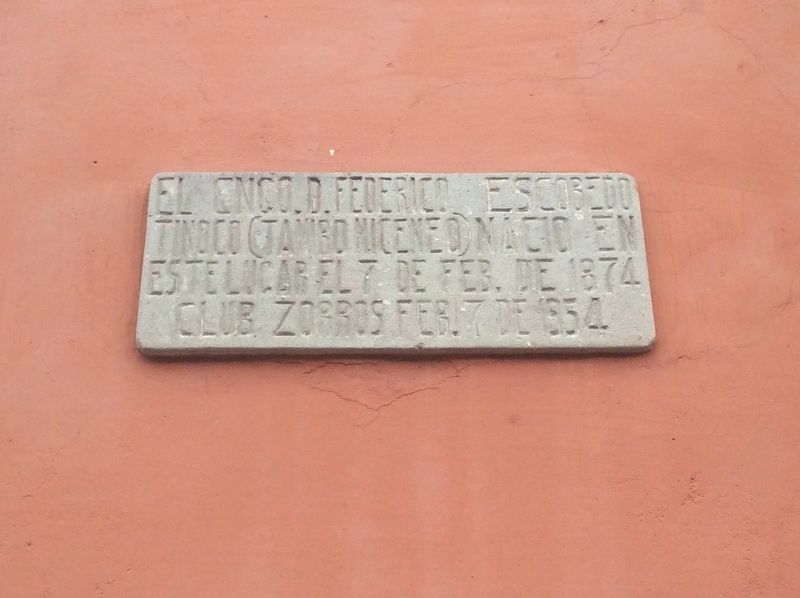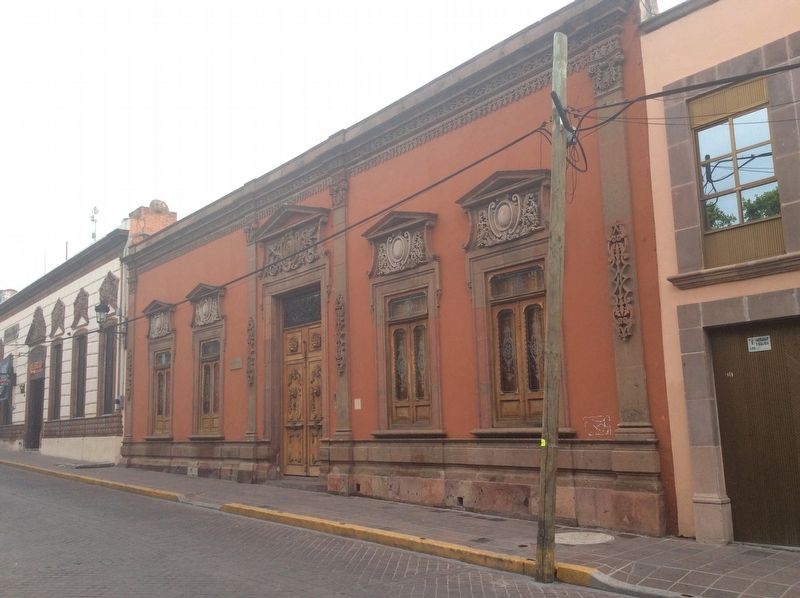Salvatierra, Guanajuato, Mexico — The Central Highlands (North America)
Federico Escobedo Tinoco
El Cnco. D. Federico Escobedo
Tinoco (Tamiro Miceneo)
nacio en
este lugar el 7 de Feb. de 1874
Club Zorros Feb. 7 de 1954
Federico Escobedo Tinoco
(Tamiro Miceneo)
was born here on February 7, 1874
Zorros Club – February 7, 1954
Erected 1954 by Club Zorros.
Topics. This historical marker is listed in these topic lists: Arts, Letters, Music • Charity & Public Work • Churches & Religion. A significant historical date for this entry is February 7, 1874.
Location. 20° 12.958′ N, 100° 52.961′ W. Marker is in Salvatierra, Guanajuato. Marker is on Calle Miguel Hidalgo just south of Calle 16 de Septiembre, on the right when traveling south. Touch for map. Marker is in this post office area: Salvatierra GTO 38900, Mexico. Touch for directions.
Other nearby markers. At least 8 other markers are within walking distance of this marker. Church and Former Convent of San Buenaventura (about 120 meters away, measured in a direct line); Portal Juárez (about 120 meters away); 175th Anniversary of the Beginning of Mexican Independence (about 120 meters away); Cardinal Juan Jesús Posadas Ocampo (about 120 meters away); Diocesan Shrine of Nuestra Señora de La Luz (about 150 meters away); Dr. Jesús Guisa y Azevedo (about 210 meters away); Agustín de Carranza y Salcedo (about 210 meters away); The Founders of Salvatierra (approx. 0.3 kilometers away). Touch for a list and map of all markers in Salvatierra.
Regarding Federico Escobedo Tinoco. Federico Escobedo Tinoco (1874-1949) was a priest, scholar, writer and opponent of the Reform Laws. Federico made his first studies in his hometown at the Colegio de la Purísima Concepción. Being supported by the parish priest Tirso Rafael Córdoba, he moved to Puebla to enter the Palafoxiano Seminary where he studied Humanities and Latin. In 1889 he entered the Society of Jesus in the Novitiate College of San Simón de Michoacán. In 1894 he traveled to Spain to study Philosophy in Oña, a town in the province of Burgos. He returned to Mexico and taught at the San Simón Novitiate College, the Colegio de San Juan Nepomuceno de Saltillo and the Colegio de Mascarones in Mexico City. In 1899, for family reasons, he resigned from the Society of Jesus and was ordained a priest. From 1900 to 1914 he
taught at the Palafoxian Seminary and, in parallel, since 1908, at the Catholic University of Puebla. He devoted himself to the translation and teaching of classical literature in the Latin language. Due to his work, the Academy of Arcadia in Rome granted him a title under the pseudonym Tamiro Miceneo. In 1914, during the development of the events of the Mexican Revolution, he was appointed a corresponding member of the Mexican Academy of Language, at the same time he took charge -provisionally- of the archdiocese of Puebla. On October 4, 1918, he was appointed a corresponding member of the Royal Spanish Academy. In 1921 he was appointed pastor of Teziutlan, where he dedicated himself to the translation of Latin into the Spanish language of Rafael Landívar's Rusticatio mexicana, the work was published in 1925 by the Ministry of Public Education. In 1927, during the events of the Cristero War, he was imprisoned in the garrison of Mexico City. Days later, he was able to return to his parish, and years later, he was appointed canon of Puebla. He came to belong to the literary group Bohemia Poblana being one of its most distinguished members, the group gathered a large part of the Puebla intelligentsia. After his death the group promoted the dedication of a park and a bust in his name located on Calle 16 September and Calle 21 Oriente of the city of Puebla. In 1940, he was appointed
corresponding member of the Colombian Academy of the Language. He wrote more than fifty titles, including books, pamphlets and other compositions; among them are Carmina Latina, Odes Breves and Madrigales Marianos. He died on November 13, 1949 in the city of Puebla. Translated and adapted from Wikipedia in Spanish
Credits. This page was last revised on April 5, 2024. It was originally submitted on May 18, 2018, by J. Makali Bruton of Accra, Ghana. This page has been viewed 181 times since then and 10 times this year. Photos: 1, 2. submitted on May 18, 2018, by J. Makali Bruton of Accra, Ghana.

